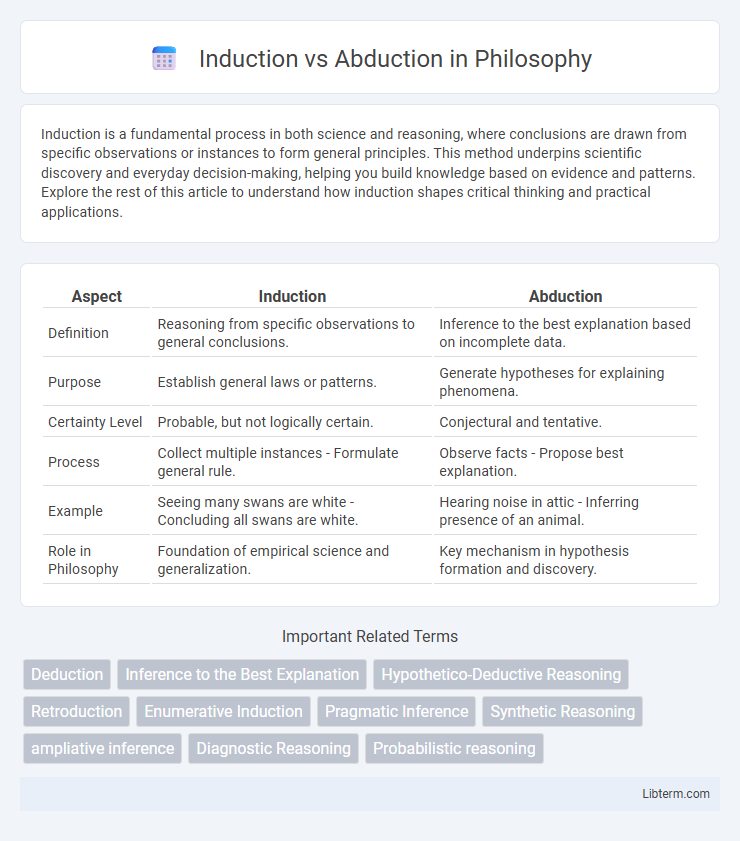Induction is a fundamental process in both science and reasoning, where conclusions are drawn from specific observations or instances to form general principles. This method underpins scientific discovery and everyday decision-making, helping you build knowledge based on evidence and patterns. Explore the rest of this article to understand how induction shapes critical thinking and practical applications.
Table of Comparison
| Aspect | Induction | Abduction |
|---|---|---|
| Definition | Reasoning from specific observations to general conclusions. | Inference to the best explanation based on incomplete data. |
| Purpose | Establish general laws or patterns. | Generate hypotheses for explaining phenomena. |
| Certainty Level | Probable, but not logically certain. | Conjectural and tentative. |
| Process | Collect multiple instances - Formulate general rule. | Observe facts - Propose best explanation. |
| Example | Seeing many swans are white - Concluding all swans are white. | Hearing noise in attic - Inferring presence of an animal. |
| Role in Philosophy | Foundation of empirical science and generalization. | Key mechanism in hypothesis formation and discovery. |
Introduction to Induction and Abduction
Induction involves reasoning from specific observations to general conclusions, enabling the formulation of hypotheses based on empirical evidence. Abduction, or inference to the best explanation, seeks the most plausible hypothesis that accounts for a given set of observations. Both induction and abduction play crucial roles in scientific inquiry, with induction emphasizing pattern recognition and abduction focusing on explanatory reasoning.
Defining Inductive Reasoning
Inductive reasoning involves drawing generalized conclusions from specific observations or evidence, allowing for probable but not certain outcomes. This approach forms hypotheses based on patterns or trends identified in data, which can be tested and refined over time. Induction is widely used in scientific research, where empirical evidence supports theory development and predictive modeling.
Understanding Abductive Reasoning
Abductive reasoning involves forming the most plausible explanation for a set of observations, often used when information is incomplete or uncertain. Unlike induction, which generalizes from specific instances to broader rules, abduction seeks the best possible inference that accounts for the available evidence. This process is crucial in fields like diagnostic medicine, scientific discovery, and artificial intelligence for hypothesis generation and decision-making under uncertainty.
Key Differences Between Induction and Abduction
Induction involves reasoning from specific observations to general conclusions, often resulting in probable but not certain knowledge, while abduction generates the most likely explanation for an observation, focusing on hypothesis formation. Inductive reasoning is data-driven and accumulates evidence to support a general rule, whereas abductive reasoning is inference to the best explanation, prioritizing plausibility over certainty. Key differences are seen in their goals: induction seeks to confirm patterns through repeated instances, and abduction aims to identify the best explanatory hypothesis for surprising facts.
Strengths of Inductive Reasoning
Inductive reasoning excels in generating generalized conclusions from specific observations, making it essential for hypothesis formation and scientific discovery. Its strength lies in the ability to handle large datasets and identify patterns, enabling predictions and the development of theories with a high degree of flexibility. Inductive methods foster continuous learning and adaptation, as new evidence can easily refine or alter derived conclusions.
Advantages of Abductive Reasoning
Abductive reasoning excels in generating hypotheses from incomplete or ambiguous data, enabling quicker decision-making in uncertain situations. It allows for creative problem-solving by identifying the most plausible explanations without requiring exhaustive evidence. This approach is particularly advantageous in fields like medical diagnosis and intelligence analysis where timely insights are crucial.
Common Applications of Induction
Induction is widely applied in scientific research to formulate general laws or theories based on specific observations, such as deriving the principles of physics from experimental data. It is commonly used in machine learning algorithms to identify patterns and predict outcomes by generalizing from training datasets. Inductive reasoning also plays a crucial role in medical diagnosis, where symptoms are analyzed to infer potential diseases.
Practical Uses of Abduction
Abduction is primarily used in diagnostic reasoning where generating the most plausible explanation for observed data is essential, such as in medical diagnosis and fault detection in engineering systems. It allows investigators to formulate hypotheses from incomplete information, guiding experimental design and decision-making processes in complex environments. This reasoning method enhances artificial intelligence applications by improving inferential accuracy in machine learning, natural language understanding, and expert systems.
Induction vs Abduction: Real-World Examples
Induction involves deriving general principles from specific observations, such as a scientist noting multiple instances of metal expanding when heated to conclude that all metals expand under heat. Abduction, by contrast, is about forming the most likely explanation for a given set of observations, like a doctor inferring a diagnosis based on symptoms that best explain the patient's condition. In real-world scenarios, induction guides the development of scientific laws, while abduction drives hypothesis generation in medical diagnostics and criminal investigations.
Choosing the Right Reasoning Method
Choosing the right reasoning method depends on the context and goals of the inquiry, where induction generalizes from specific observations to broader theories, ideal for data-driven conclusions. Abduction generates the most plausible explanations for incomplete or surprising facts, making it crucial for hypothesis formation and problem-solving in uncertain situations. Effective decision-making requires assessing whether the problem demands predictive generalization (induction) or explanatory inference (abduction) to optimize outcomes in research, diagnostics, or artificial intelligence.
Induction Infographic

 libterm.com
libterm.com